Another mystery car
Discussion
Doofus said:
Given that it's pretty likely to be the only example built, the likelihood is that is was registered as a Ford or Austin or something, so 'data crunching' as you describe wouldn't produce anything anyway.
Good point. Would that apply to things like Ashleys and so on too? That person saying "it's a Photoshop..." for heaven's sake

My understanding is that when first registered, the make and model of the car was fixed and could not be changed. So yes, in the UK the log book, and the tax disc displayed in the windscreen, would always state the original manufacturers name, and that this would also appear on any official tax and owner registration records.
Only if the car was registered as "new" could it have been registered as an Ashley, Falcon or whatever. That should have meant an entirely brand new vehicle with a brand new frame and all major mechanical parts. There may have been ways around this, but even a new spaceframe and body shouldn't have been enough on their own.
The one possible loophole would be vehicles previously registered outside the UK. If you imported the vehicle, converted it, then UK registered it, then who knows?
Only if the car was registered as "new" could it have been registered as an Ashley, Falcon or whatever. That should have meant an entirely brand new vehicle with a brand new frame and all major mechanical parts. There may have been ways around this, but even a new spaceframe and body shouldn't have been enough on their own.
The one possible loophole would be vehicles previously registered outside the UK. If you imported the vehicle, converted it, then UK registered it, then who knows?
Using the Borrani and/or _sorted_ approach to establishing potential base donor vehicles, you could theoretically run queries show, for example [all blue Ford Popular] or whatever. It would still be a pretty big number I guess, but in my head cars built in the '50s (which the donor would probably have been) were mainly grey or black. I think blue would have been relatively unusual, and might also have been recorded as a colour change (if they recorded colour changes back then). An old PHer will know this stuff.
I don't know why I'm bothering to write this, it ain't gonna happen.
I don't know why I'm bothering to write this, it ain't gonna happen.
If you save this, a detail taken from Sorted's high resolution scan, you can enlarge it and see an almost legible registration number.....
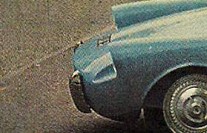
The white stripe is central - it has to be, as it runs across the roof between the doors. The middle digit aligns with the stripe just this side of centre.
From the alignment of the digits with the white stripe, I am certain it has only three digits - quite distinctive even in 1962.
The first digit can't be read, but there seems to be a gap before the more closely spaced second and third digits. The final digit is a '3' so, on UK plates, this means a single letter followed by two number digits.
The middle digit is possibly a '5', '6' or '8'.
'I', 'O' and 'Q' are not used on UK plates, and 'Z' is reserved for northern Ireland, leaving 22 possible letters, most likely followed by ';53', '63' or '83'. That would be one of 66 combinations.
If the records were available, then it wouldn't be too difficult to note down any three-digit (and four-digit, just to be safe) numbers ending in three, on blue cars, registered in central London, in 1962.
Can't be too many.
Does anyone know where the records may be kept, if they still exist?

The white stripe is central - it has to be, as it runs across the roof between the doors. The middle digit aligns with the stripe just this side of centre.
From the alignment of the digits with the white stripe, I am certain it has only three digits - quite distinctive even in 1962.
The first digit can't be read, but there seems to be a gap before the more closely spaced second and third digits. The final digit is a '3' so, on UK plates, this means a single letter followed by two number digits.
The middle digit is possibly a '5', '6' or '8'.
'I', 'O' and 'Q' are not used on UK plates, and 'Z' is reserved for northern Ireland, leaving 22 possible letters, most likely followed by ';53', '63' or '83'. That would be one of 66 combinations.
If the records were available, then it wouldn't be too difficult to note down any three-digit (and four-digit, just to be safe) numbers ending in three, on blue cars, registered in central London, in 1962.
Can't be too many.
Does anyone know where the records may be kept, if they still exist?
borrani72 said:
If you save this, a detail taken from Sorted's high resolution scan, you can enlarge it and see an almost legible registration number.....

The white stripe is central - it has to be, as it runs across the roof between the doors. The middle digit aligns with the stripe just this side of centre.
From the alignment of the digits with the white stripe, I am certain it has only three digits - quite distinctive even in 1962.
The first digit can't be read, but there seems to be a gap before the more closely spaced second and third digits. The final digit is a '3' so, on UK plates, this means a single letter followed by two number digits.
The middle digit is possibly a '5', '6' or '8'.
'I', 'O' and 'Q' are not used on UK plates, and 'Z' is reserved for northern Ireland, leaving 22 possible letters, most likely followed by ';53', '63' or '83'. That would be one of 66 combinations.
If the records were available, then it wouldn't be too difficult to note down any three-digit (and four-digit, just to be safe) numbers ending in three, on blue cars, registered in central London, in 1962.
Can't be too many.
Does anyone know where the records may be kept, if they still exist?
O is used in UK plates. I have a 3 letter 2 number plate with an O.
The white stripe is central - it has to be, as it runs across the roof between the doors. The middle digit aligns with the stripe just this side of centre.
From the alignment of the digits with the white stripe, I am certain it has only three digits - quite distinctive even in 1962.
The first digit can't be read, but there seems to be a gap before the more closely spaced second and third digits. The final digit is a '3' so, on UK plates, this means a single letter followed by two number digits.
The middle digit is possibly a '5', '6' or '8'.
'I', 'O' and 'Q' are not used on UK plates, and 'Z' is reserved for northern Ireland, leaving 22 possible letters, most likely followed by ';53', '63' or '83'. That would be one of 66 combinations.
If the records were available, then it wouldn't be too difficult to note down any three-digit (and four-digit, just to be safe) numbers ending in three, on blue cars, registered in central London, in 1962.
Can't be too many.
Does anyone know where the records may be kept, if they still exist?
borrani72 said:
Does anyone know where the records may be kept, if they still exist?
As I understand it, records were kept by the local authority responsible for issuing registration numbers up until 1972 (?) when the DVLA in Swansea took over. Some archives were transferred to Swansea, others kept by the LA - and possibly destroyed then or later. I know that Warwick Records Office, for example, retained their records (I was trying to trace an Austin-Healey's number using them, as the cars were built in Warwick and many were registered by the factory). Unfortunately, to identify the registration office you need to know the last two letters of the plate.uk66fastback said:
A guy on one of the Facebooks groups says it is an Ashley Harrington 'prototype' or something ... I'll have to go find what he said ...
Found it ...
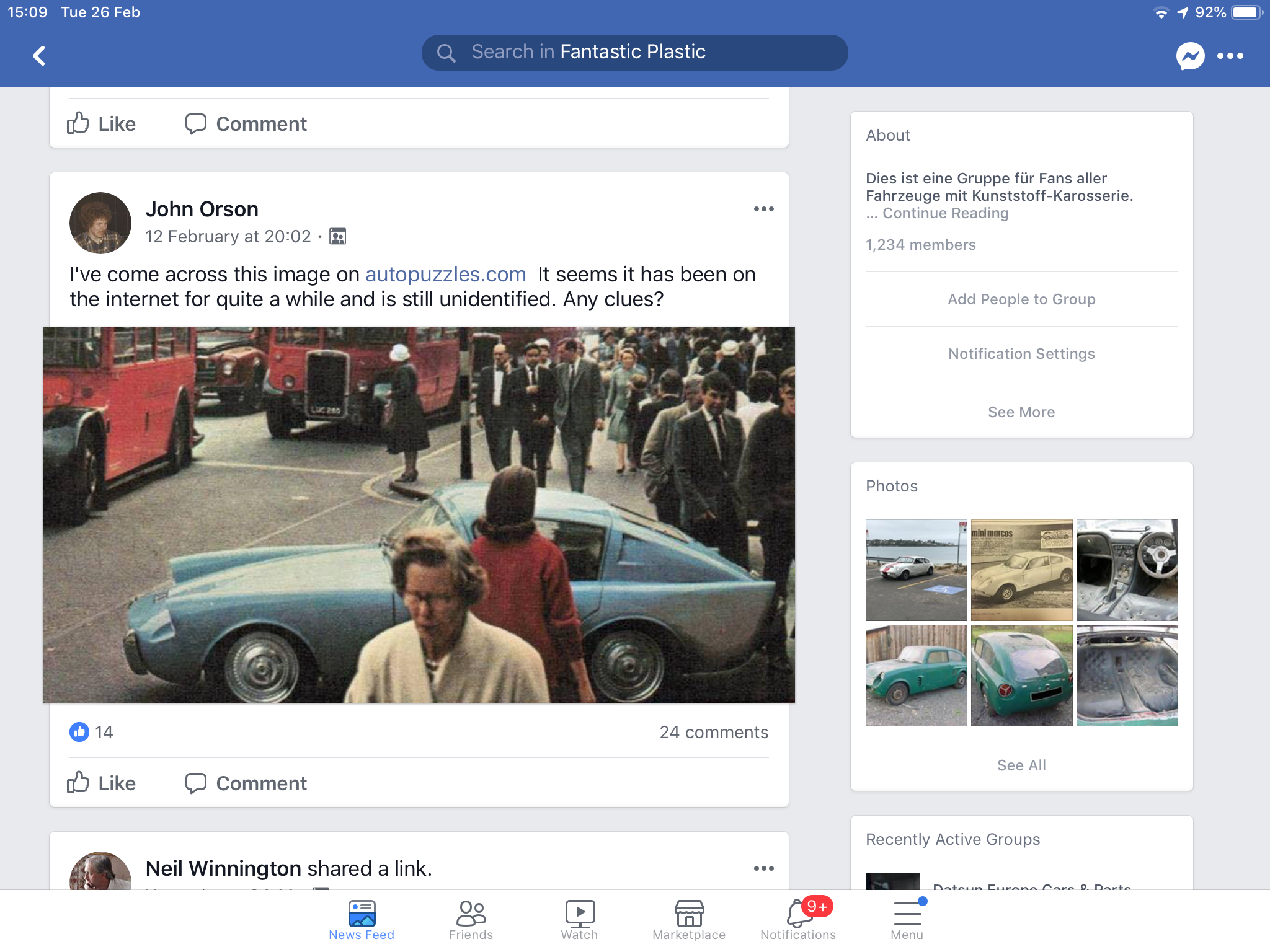
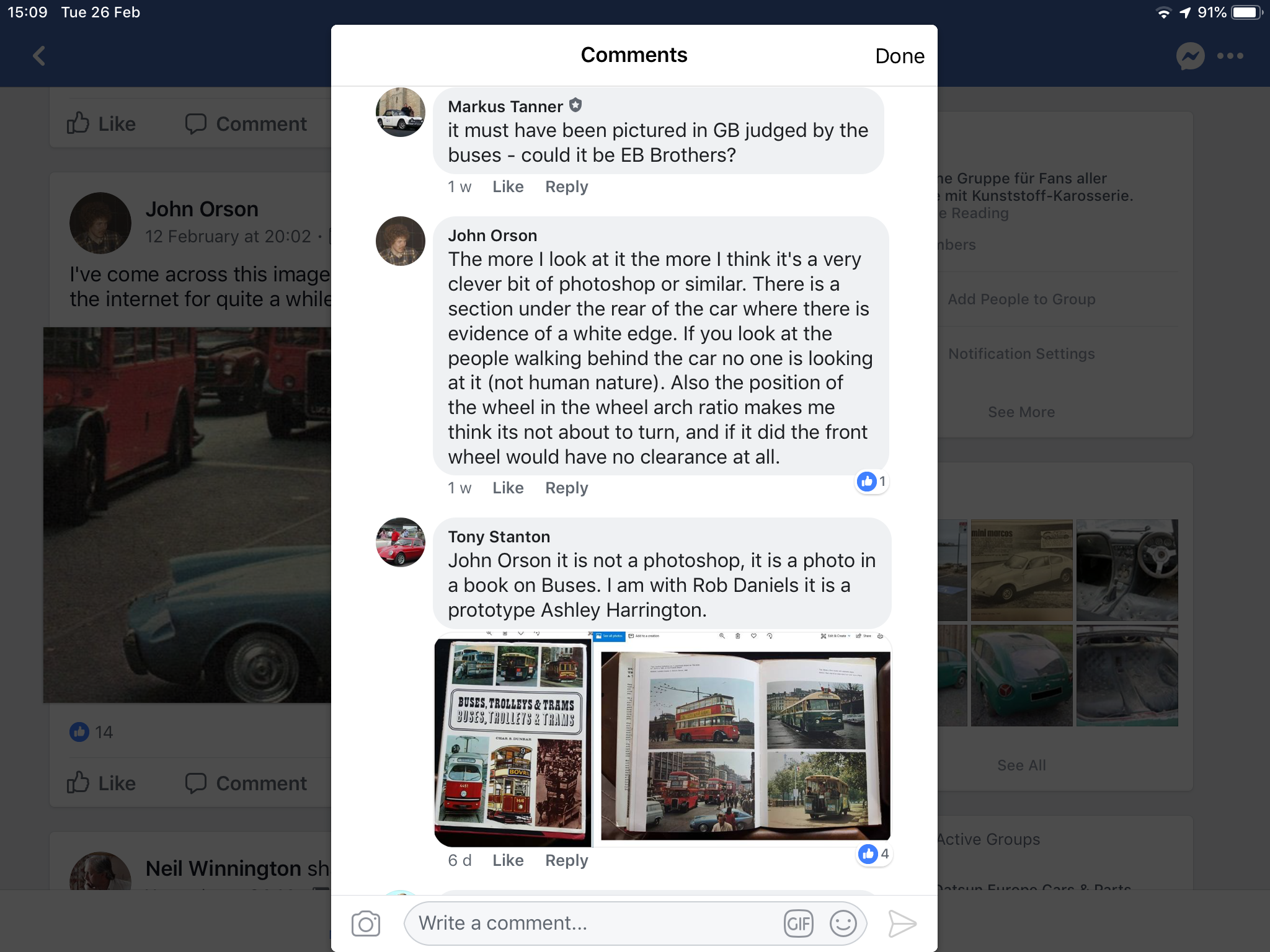

I think it were made by a company like Ashley more evidence would be available ...
I've done a little research on Ashley Laminates, and found a couple of related things.Found it ...



I think it were made by a company like Ashley more evidence would be available ...
There was an Ashley MKVI. It was a chassis with an 8 foot wheellbase, primarily intended for their Sportiva body as an alternative to the Ford chassis. It came with a fibreglass floor moulding with integral rear seat structure.

Applying the ratio of wheelbase and wheel size to the mystery car, if its' wheelbase were 8 feet, then the wheels would be 18". This seems unlikely as smaller wheel sizes where becoming more common, and the Triumph TR based Ashley models had 15" wheels. Plus the chassis was intended as a four seater.
I also discovered this. An Ashley alternative to the Harrington Alpine. I suspect this is where the 'Harrington' name on Facebook may have been remembered from?
And this perhaps the 'prototype' referred to.....
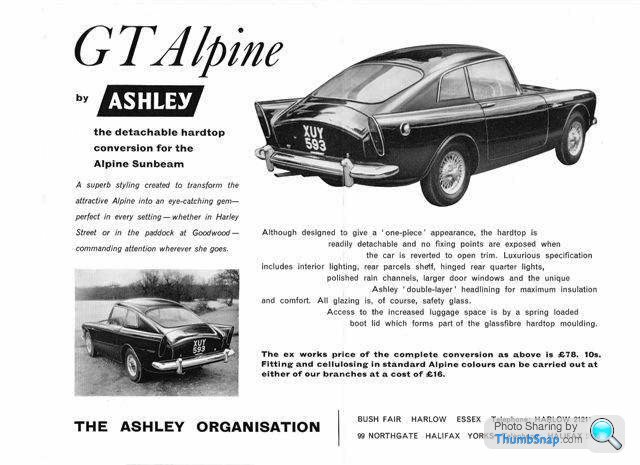
Did they develop a production version?
Coachbuilder Thomas Harrington and Sons built four different fastback conversions for the Alpine, the earliest dating from 1961. The Alpine was launched in 1959. I would guess that the Ashley version was later. Below, and early example of a Harrington.
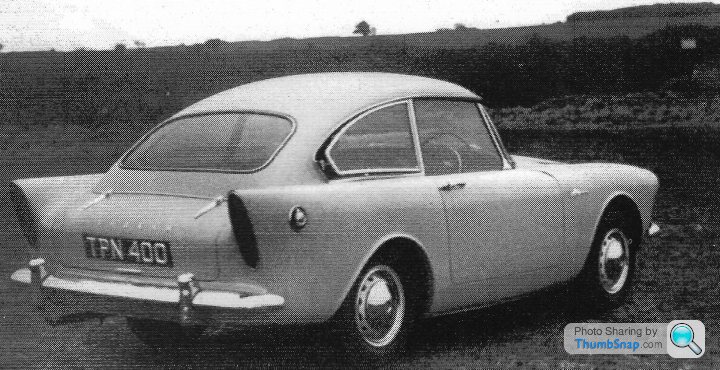
Harrington also operated as a Rootes Group (Hillman, Singer, Sunbeam, Humber) agency, so were able to sell their conversion through several selected dealerships - perhaps this is why the Ashley version doesn't appear to have progressed beyond the advertisement.
I tend to agree with uk66fastback that if Ashley had built the mystery car, then it would be known about. They were a small company operating from two sites. One a showroom, the other the factory. The factory had two 'layup' rooms, the larger producing bodies, the other, smaller parts.
They were developing the old Ashley bodies into the Sportiva and also moving into the more lucrative fibreglass hardtop market at the time. I doubt they had the interest or resources to develop an all new model at the same time. And even if they did, why keep it so secret - companies like Ashley depended upon publicity for their very existence?
borrani72 said:
Ooops! You're quite right.
Q isn't used because it looks like an O. But yes, O is used.......
The MOT site lists the following combos - Q isn't used because it looks like an O. But yes, O is used.......
D53 D83 E53 G63 G83 H53 H63 L63 M53 M63 N63 O53 R63 S53 S63 S83 T83 X53 X63 X83. However, others may have been scrapped or on retention. None have been sold at a DVLA auction so are all likely original issues.
D53 is on a 1935 daimler, N63 on a 1935 bentley and O53 on a 1928 wolsley so these could be their original numbers and can probably be discounted.
All the above based on what you 'may' have been able to read on that sketchy photo!
borrani72 said:
Hi Piper,
WATERLOO PLACE
I'm guessing the mystery car would have been somewhere around the position of the white estate car just above the red van in the picture?
Given that this is one way, did you pass this spot as you arrived in London, on the return journey, or perhaps both?
I've looked at a lot of period images, and not found any pictures with the mystery car (so far). I was wondering whether your journey was weekday or weekend, and whether you can recall roughly what time of day you saw the car?
borrani I think you are spot on with the positioning of the car, as I have said before it was always driven in front first, so my memories are mainly from the side and back, again from memory the paint looked liked metallic blue but it certainly had lost all its lustre and was very flat in appearance. The car was always seen during a weekday, we used to catch the coach during school holidays and I used to look out for the car during the inbound trip. I do vaguely remember seeing the car going home once. I will try to get in the loft over the weekend and see what I can find. Also, do you have the link for the London video clip of the Rometsch Lawrence? I would love to see that.WATERLOO PLACE
I'm guessing the mystery car would have been somewhere around the position of the white estate car just above the red van in the picture?
Given that this is one way, did you pass this spot as you arrived in London, on the return journey, or perhaps both?
I've looked at a lot of period images, and not found any pictures with the mystery car (so far). I was wondering whether your journey was weekday or weekend, and whether you can recall roughly what time of day you saw the car?
Edited by piper on Friday 1st March 09:24
Edited by piper on Friday 1st March 09:30
piper said:
borrani I think you are spot on with the positioning of the car, as I have said before it was always driven in front first, so my memories are mainly from the side and back, again from memory the paint looked liked metallic blue but it certainly had lost all its lustre and was very flat in appearance. The car was always seen during a weekday, we used to catch the coach during school holidays and I used to look out for the car during the inbound trip. I do vaguely remember seeing the car going home once. I will try to get in the loft over the weekend and see what I can find. Also, do you have the link for the London video clip of the Rometsch Lawrence? I would love to see that.
Most likely somebody working in the area, or retired and spending the day in one of the clubs maybe.I had wondered whether the paint was metallic. That was my first impression, though the more I've looked at it the more I began to suspect it was a solid colour as the graininess is a result of the printing process.
However, when marker rendering, to suggest a metallic finish it is common practice to substitute a 'lowlight' (dark area) where you would normally expect a highlight. This is because the metallic particles reflect light in all directions from inside a clear carrier, whereas solid colours reflect from the surface geometry alone.
Here's 1960s Genersal Mortors' designers Tony Lapine and the legendary Larry Shinoda (below) with a prime example - note the dark area running between and over the wheel arches to suggest a metallic finish.....
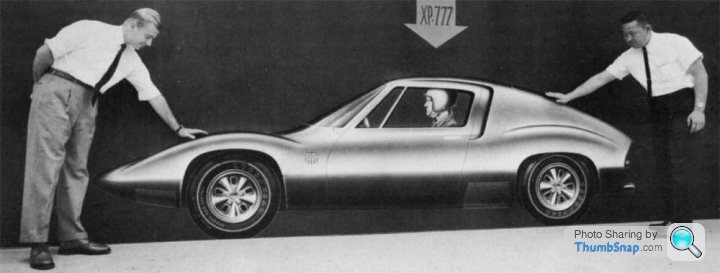
....and something similar along the front wing...........
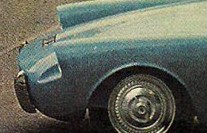
Real world reflections are more complex, so it's hard to be definitive from this. Your memory is probably a better clue.
Due to the colour distortions from the film emulsion, camera settings and from the offset lithography printing process, as well as the way the brain creates the experience of colour, you can't get an accurate colour sample from a photograph, though I would imagine, going on the appearance of the other vehicles in the image, it could be something like Jaguar Opalescent Silver Blue..........
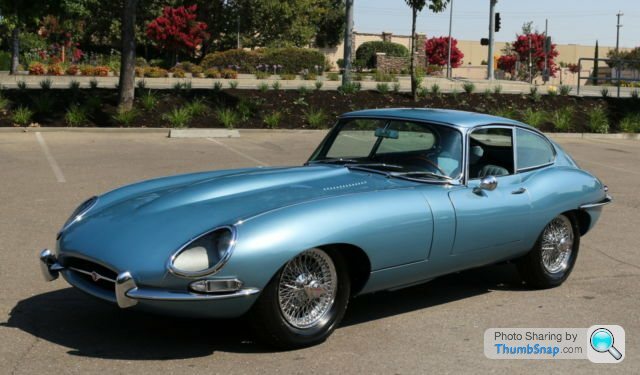
And here's a dull, lustreless example.......
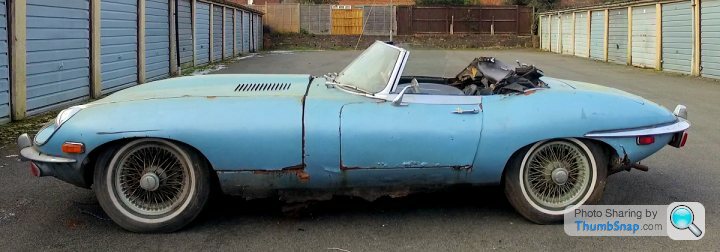
Is this anywhere close to your memory?
Yertis said:
piper said:
I will try to get in the loft over the weekend and see what I can find.
Wouldn't it be amazing to find a pic of 'the mystery car' showing its registration.Chances are we won't, sadly, even if we could find out the reg.
We have so little to go on, that I think we can only try to piece together whatever we can, and see where it leads us.
Even if we never discover the name of the builder, or the story behind the car, we can still get a better idea of how it looked using photomatching in a CAD progamme. If we can find more photo's, even one, then this becomes more accurate as we can test fit a working CAD model against two or more images and refine the model to match both.
I'm certain I'm not the only one that would love to know exactly what it looked like from the front and rear, and for that alone, I think the search for more images is entirely justified.
If that bright area on the boot lid is a badge, another photo' might tell us what badge.
Plus, more images may lead to more locations, perhaps an address, a name from the old electoral rolls or the director of a business from Companies House. And from the registrars, we may eventually trace relatives of the builder......
This is why I was so keen to trace somebody from the publishers. You never know where a lead may take you. Unfortunately, when I contacted Nicholas Maddren, the books designer, he could only tell us that the picture came from an agency, most likely The London Transport Board.
https://en.wikipedia.org/wiki/London_Transport_Boa...
If we can trace the original image - a photographic print or the negative - this will be a clearer, sharper image than that from the book. We may very well be able to read the number plate. If we have that, we can try tracing the vehicle through the DVLC or local authority records, or ask clubs, like the Austin Seven Owners Club for example, whether they have any records relating to that number - who knows what old records are out there.
Even if we never discover the name of the builder, or the story behind the car, we can still get a better idea of how it looked using photomatching in a CAD progamme. If we can find more photo's, even one, then this becomes more accurate as we can test fit a working CAD model against two or more images and refine the model to match both.
I'm certain I'm not the only one that would love to know exactly what it looked like from the front and rear, and for that alone, I think the search for more images is entirely justified.
If that bright area on the boot lid is a badge, another photo' might tell us what badge.
Plus, more images may lead to more locations, perhaps an address, a name from the old electoral rolls or the director of a business from Companies House. And from the registrars, we may eventually trace relatives of the builder......
This is why I was so keen to trace somebody from the publishers. You never know where a lead may take you. Unfortunately, when I contacted Nicholas Maddren, the books designer, he could only tell us that the picture came from an agency, most likely The London Transport Board.
https://en.wikipedia.org/wiki/London_Transport_Boa...
If we can trace the original image - a photographic print or the negative - this will be a clearer, sharper image than that from the book. We may very well be able to read the number plate. If we have that, we can try tracing the vehicle through the DVLC or local authority records, or ask clubs, like the Austin Seven Owners Club for example, whether they have any records relating to that number - who knows what old records are out there.
To get hold of the transparency or even a print would be great. I would think shooting onto transparency film is how this would have been photographed back then. I'm sure a few of us have memories of a Sunday afternoon with the curtains drawn, as dad yet again went through the holiday snaps on the projector to the amazement of us all. I wouldn't think it was an old plate camera.
Whether the London Transport Museum hold these things in some vast vault I have no idea. That's of course, IF it came from them.
Bearing in mind the fact the image in the book looks to have been retouched in some areas, I am sure it was scanned from a large continuous tone print. Where that print is, is anyone's guess.
Whether the London Transport Museum hold these things in some vast vault I have no idea. That's of course, IF it came from them.
Bearing in mind the fact the image in the book looks to have been retouched in some areas, I am sure it was scanned from a large continuous tone print. Where that print is, is anyone's guess.
Gassing Station | Classic Cars and Yesterday's Heroes | Top of Page | What's New | My Stuff



